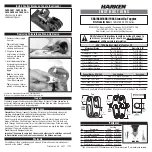DigiConvert Operating Instructions
Copying this document, or disclosing it to third parties is not allowed without our approval. This document must not be used in any abusive way by the receiver or third
parties. Fe Vogt GmbH
DigiConvert Operating Instructions
66 of 79
1. Number of teeth of the tool cylinder:
Enter the number of teeth of the punch tool cylinder here. Enter the new number of teeth here when
you install another tool.
The resulting punching cylinder circumference is shown in mm for information.
2. Number of punch contours per cylinder circumference in web run:
Enter the number of punch contours per cylinder circumference in web run direction here. Enter the
new number of punch contours when you install another cylinder.
3. Number of punch contours across the web run
Enter the number of punch contours across the web run here.
4. Homing with sensor
Specify here whether homing uses a sensor.
5. Punching sheet length [mm] (only in punching mode: Translative)
Specifies the length of the punching sheet. This means the length of all punch contours including gaps
(such as stays).
This entry shows the max. web speed that is possible with the entered value.
It also shows the min. and max. possible length of the punching sheet.
6. Punching sheet offset [mm] (only in punching mode: Translative)
Here you can enter an additional offset from the punching sheet edge to the beginning of the punch
contour.
7. Synchronisation distance after the punching sheet in [mm] (only in punching mode:
Translative)
Here you can enter an additional synchronisation distance in front of the punching sheet.
Recommendation: 10mm
8. Synchronisation distance after the punching sheet in [mm] (only in punching mode:
Translative)
Here you can enter an additional synchronisation distance after the punching sheet.
Recommendation: 10mm
9. Punching sheet correction value [mm] (only in punching mode: Translative)
Here you enter a correction value for the punching sheet. This permits the punching length on the web
to be modified.


















